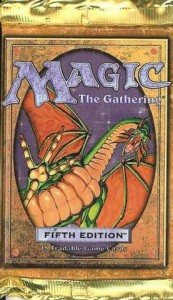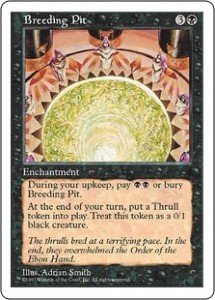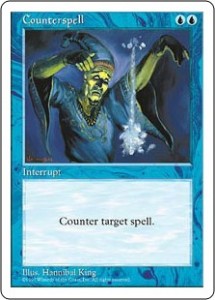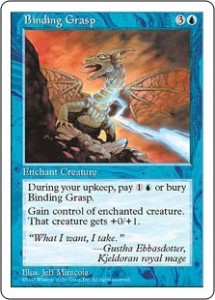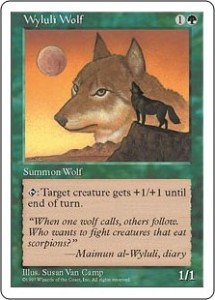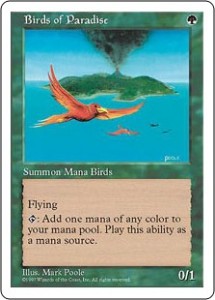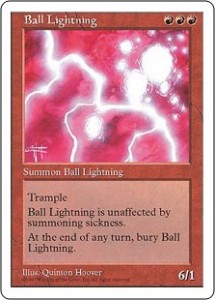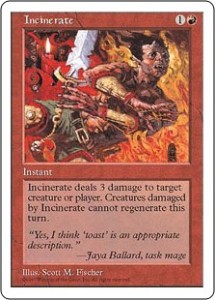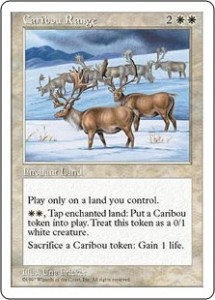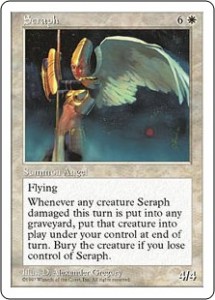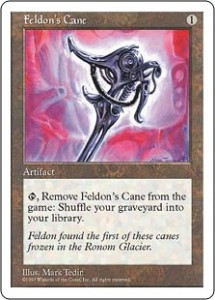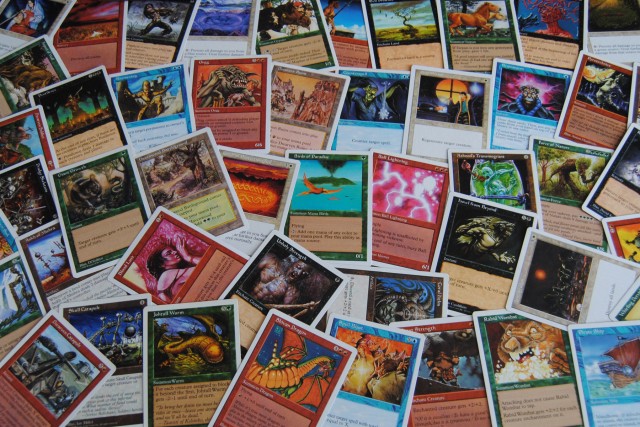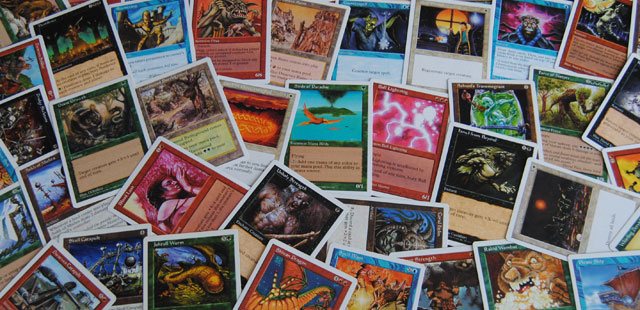
An Introduction to Fifth Edition
Magic: The Gathering’s Fifth Edition was released March 31, 1997, with 429 cards, not including Basic Land and at its heart, Fifth Edition was very much an amalgamation of many different sets.
At its base was Fourth Edition, then 194 additions were made; one card from Arabian Nights, 37 from Chronicles of which eight were reprints from Antiquities, four were reprints from Arabian Nights, were 18 reprints from Legends and seven were reprints from The Dark. 29 were added from Fallen Empires, 29 from Homelands, 89 from Ice Age, five from Legends, two from Revised that were reprints from Antiquities and two from The Dark.
There were 128 cards from Fourth Edition that were not included in Fifth Edition, most notably, many of the then Type II restricted cards; such as Balance, Black Vice, Ivory Tower and Land Tax, to name a few, as well as two notable flyers; Serra Angel and Sengir Vampire.
A total of 220 cards had new artwork that differed from their original printings. This was not a change in game play, but it was a cosmic shift in the way card art would be revised and changed over the coming basic core sets of the future.
See a complete list of the Additions and Subtractions from Fourth to Fifth Editions.
Unlike Fourth Edition, which stayed very close to Revised, which stayed close to Unlimited, which was pretty much a carbon copy of Alpha and Beta, Fifth Edition incorporated many of the sets that came between Fourth Edition and Mirage.
Some of the cards where not just removed they were outright replaced. Abyssal Specter replaced hypnotic Specter and Incinerate replaced Lightning Bolt, this would be a pattern over the next few sets, as Wizards of the Coast was not biased to just rarity when determining which cards were too powerful.
The Lands of Fifth Edition: Some Pain, some Storage, but no Strip, no Factory and no Oasis
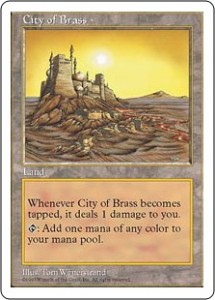
Fifth Edition’s City of Brass was originally printed in Arabian Nights and was reprinted in Chronicles
There were 25 Lands printed in Fifth Edition; the five Basic Land, each of the five sacrifice Lands from Fallen Empires, each of the five storage Lands from Fallen Empires, each of the five Pain Lands from Ice Age, all three Urza’s Lands from Chronicles, Ice Floe from Ice Age and City of Brass from Chronicles.
Mishra’s Factory, Oasis and Strip Mine were all removed from Fourth to Fifth Editions, which was disappointing. Mishra’s Factory was a great addition to any deck of any type and Black and/or Red Land destruction sorely missed Strip Mine.
It was interesting to see all of the sacrifice and storage Lands from Fallen Empires added to the set and the dual lands of Revised, not printed in Fourth Edition were replaced by the Pain Lands of Ice Age.
The addition of all of these non-basic Lands played havoc with some of the “search your library for a basic land” spells that existed, because players were now using more non-basic Lands than ever before. After all, the original Dual Lands of Revised counted as both types of Basic Land, where the Pain Lands of Ice Age did not.
The Color Black in Fifth Edition: Hello Abyssal, Goodbye hypnotic and other Changes
Fifth Edition Black had some powerful additions in Hecatomb and Necropotence from Ice Age and Breeding Pit from Fallen Empires. But there were players of the color mourned the straight losses of Royal Assassin and Will-O’-the-Wisp.
As great as the three big additions were, it was no consolation for the famous Black combo of Royal Assassin and Icy Manipulator and there would be no equal to, the now out of print, Will-O’-the-Wisp’s first turn defense.
However, amid the additions and losses, Black was able to hang on to a lot of it’s staple power cards. Animate Dead remained unharmed, Bad Moon which gives all Black creatures +1/+1 also remained in print.
Big creatures like Lord of the Pit and Nightmare were kept in the base core set and utility creature Sorceress Queen stayed as well.
Dark Ritual’s reprinting was of great relief to all players, although it would be be close to the end of it’s rope. It would be printed in other future stand alone expansion sets, but it would not be seen in Seventh, Eight or any of the other core non-expansion sets.
Sengir Vampire was not printed in Fifth, but seemed to be replaced by Fallen Angel, which had been a Legends reprint in Chronicles. Mind Twist was replaced by Mind Warp, which was a similar card, but cost more to cast.
But the biggest fallout in Black was the end of hypnotic Specter, which had been replaced in Fifth Edition by Ice Age’s Abyssal Specter. Although they were similar and Abyssal Specter was the stronger of the two at 2/3, compared to 2/2, it was the loss of the hypnotic Specter as a first turn play that hurt the most. As the hippy could be cast first turn with a Swamp and a Dark Ritual.
The Color Blue in Fifth Edition: Retaining Control of the Magic and Grasping for Counterspells
Blue’s Fifth Edition changes were not quite as monumental as those in Black. The counter spell library was bolstered by the additions of Ice Age‘s Deflection and reprint of Force Spike, which was last seen in Legends.
Lost to Blue were two cards a common in Apprentice Wizard and a rare in Psionic Entity, but it was the Wizard’s loss, even though it was a common that was the bigger deal.
Apprentice Wizard turned one Blue Mana into three Colorless Mana and this was something that, by the time Fifth Edition was printed, players were really starting to exploit as a Mana source advantage.
However, Counterspell remained in print, which was good news for Blue, although its, like Dark Ritual’s, days would be numbered.
Merfolk decks were happy to see Lord of Atlantis retained as with each new set, more Merfolk were building it to the tribe it is today and Blue’s hulking Leviathan was also reprinted in Fifth.
Big Blue concept decks built around Stasis and/or Time Elemental were happy to see those two cards reprinted as well. At this time Stasis was a common deck theme for Blue.
Unfortunately it wasn’t all good news for Blue. Although Mirage had given Blue Mist Dragon, it’s staple flyer in Mahamoti Djinn was replaced by Ice Age’s Sibilant Spirit, which allowed defending player to draw a card when it attacked.
That wasn’t all, as the staple Blue control enchantment of Control Magic was replaced by Ice Age’s Binding Grasp, which although it gave the stolen creature a +0/+1 boost, also came with an upkeep cost. Which tied up Mana that could be used for Counterspells and Arcane Denials.
The Color Green in Fifth Edition: Losing a Liege but gaining so much More
Unlike Black and Blue, Green’s additions and those cards that were printed again were, for the most part, much bigger news than the losses.
Ice Age was again a huge contributor with the additions of Elder Druid, Fyndhorn Elder and Lhurgoyf. The latter two, saw their use increase from their use in Ice Age, because of their reprinting.
Homelands added hungry Mist and Carapace, while Rabid Wombat, a Legends creature reprinted in Chronicles, was also added to the mix. Also of note was the addition of Wyluli Wolf, which was last printed in Arabian Nights and was passed over in Chronicles. The Wolf also jumped from being an Arabian Nights common to a Fifth Edition rare, which was the rarity it had for it’s last printing in Sixth Edition.
The loss of Gaea’s Liege hurt deck’s that were built around the Liege’s ability to turn any Land into a basic Forest until the Liege left play. The added Rabid Wombat lost a brilliant card for the Wombat Enchantress decks of the time in Web.
Web worked well, because it cost one Green Mana, gave target creature +0/+2 and the ability to block creatures with flying. In the Wombat Enchantress deck, it also allowed you to draw a card and the Wombat would get its +2/+2 buff for being enchanted.
Rebirth was another loss, but considering it was one of the few ante cards remaining in Magic at the time, this was no surprise.
Luckily, Green maintained most of it’s staple cards, Cockatrice, the flying Thicket Basilisk which was also reprinted, Force of Nature, hurricane, Marsh Viper and most importantly Birds of paradise and Sylvan Library.
Now, Sylvan Library had lost some of its esteem with all of the library manipulation in Alliances, but it was still a valuable play. Meanwhile, Birds of Paradise was key to many two, three, four and five color decks. In fact, the Birds of Paradise was printed in every core set up through Magic 2012, with the exception of Ninth Edition. Although in Ninth Edition, it was not simply printed, but replaced by its non-flying counterpart, Utopia Tree from Invasion.
The Color Red in Fifth Edition: They Incinerated the Lightning Bolt and other Changes
Although Red would get more fun and useful cards added to its arsenal, it was the replacement of one card that hit the hardest. Before that, let’s look at the additions.
Again, Ice Age added the most to a color; Conquer, Game of Chaos and Orcish Squatters were all big additions to Red in Fifth Edition. Not to be outdone, Fallen Empires added Goblin Warrens and Orgg, while Atog returned to print for the first time since Revised.
Red’s losses were nowhere near that important, only Dragon Whelp and Uthden Troll were of any note in the cards lost.
Red maintained a lot of big important creatures in Ball Lightning, Goblin King, Keldon Warlord and Shivan Dragon. The Goblin King really benefited from the addition of the Goblin Warrens.
Spells like Blood Lust, Smoke, Earthquake and Winds of Change were also welcome reprints from Fourth Edition. But the big news of Fifth Edition belonged to Red with the replacement of it’s staple direct damage spell Lightning Bolt with Ice Age’s Incinerate.
Although, with Alliances‘ Pyrokinesis and Visions‘ Fireblast, Red could deal damage with no untapped Mana sources, the loss of Lightning Bolt, one Red Mana for three damage, was huge.
This shift meant that Red needed to have two available Mana to keep an opponent in fear and not just one, which is a huge advantage for those playing against Red. Lightning Bolt would not return for 13 years, when it was reprinted in Magic 2010. That being said, in the 13 year absence of Lightning Bolt from being in print, it was wondered if the card would ever be reprinted after all, Blue would eventually see Counterspell disappear, and it hasn’t returned yet and Dark Ritual also disappeared for a long hiatus, as well.
The Color White in Fifth Edition: Serra Angel steps down for Seraph and other Troop movements
Fifth Edition White was balanced in what it gained, lost and what was replaced.
Blinking Spirit and Caribou Range were added from Ice Age, the Range being an additional boost for creating White weenies in addition to Mirage‘s Sacred Mesa. Icatian Town from Fallen Empires was another additional way to create even more weenies, while Serra Bestiary from Homelands allowed you to pacify one of your opponents’ larger creatures, keeping all your weenies a bit safer.
However, although there were some big losses for White, they were not quite missed. Balance and Land Tax were not reprinted from Fourth Edition to Fifth, however, since they were restricted in the Type II and some of the other tournament formats at the time, it wasn’t hard to find something else to replace those two cards with.
Savannah Lions was an unfortunate loss, because if it was cast first turn, it could be enchanted with a holy Strength for a turn two 3/3 attacker. Elder Land Wurm was also not printed, although it wasn’t as missed as the Lions were.
White did retain Angry Mob, all of the Circle of Protections, Animate Wall, Eye for an Eye and Righteousness. White’s two main power cards in Armageddon and Wrath of God where also reprinted. As was Crusade, Kismet and Island Sanctuary, the latter which was combined with Homelands’ Mystic Decree as part of a lock-down deck.
The one replacement that took place in White was that the classic Serra Angel was replaced by Ice Age’s Seraph.
It was sad to see Serra Angel go, but Black did lose Sengir Vampire in this set as well. But Serra Angel, unlike some other cards, was just on a short hiatus as it would return in Seventh Edition.
The Artifacts of Fifth Edition: Say Goodbye to the Rack, Vise and Tower… Say Hello to Frozen Artifacts and a Cane
The Artifacts in Fifth Edition totaled 64 which was actually less numerous than in Fourth Edition which had 70, even with the many additions.
Again, Ice Age was the biggest contributor with Artifacts like, Crown of the Ages, Infinite hourglass, Pentagram of the Ages, Time Bomb and the fan favorite Jester’s Cap.
Chronicles also added Serpent Generator, Fountain of Youth and the deck standard of the time Feldon’s Cane.
The loss of Aladdin’s Lamp, Armageddon Clock, Clockwork Avian, Kormus Bell, Tetravus, Triskelion and Yotian Soldier were huge, especially to those who utilized those Artifact creatures that were no longer being printed. But the biggest three losses were Black Vise, Ivory Tower and The Rack, but they were restricted in Type II tournaments of that time anyway, so it wasn’t a huge loss.
Luckily, some standard Artifacts remained; Ankh of Mishra, howling Mine, Mana Vault, Millstone, Meekstone, Nevinyrral’s Disk, Ornithopter, Rod of Ruin and Winter Orb. The best news of these was howling Mine, Mana Vault, Millstone, Ornithopter and Winter Orb, which all played big parts in many decks of the time.
All five Mana Batteries were replaced by the inclusion of the Fallen Empires‘ storage Lands, which made sense, since they did basically the same thing excepting that one was an Artifact and one was a Land.
In Conclusion Fifth Edition
Fifth Edition was not printed with a set symbol, but was ultimately given a digital one by Wizards of the Coast as it did with Fourth Edition. It was, in fact, the last set to be printed without a set symbol on the physical cards.
Fifth Edition was not just a core set of what we were used to, but it was very much a core set of the core sets to come. The 194 new cards added from Fourth Edition to Fifth came from eight different sets. The 128 cards that were not printed from Fourth to Fifth were done, in hindsight, because of Type II tournaments.
All of the Restricted cards from Fourth Edition, met their ends as did many others. Banding was starting to become a joke, as it wasn’t being used. Even the newly created Flanking and Phasing abilities were being more widely used.
Now with all of this change, no new cards were created for Fifth Edition, as it was a core set, but 220 cards had completely new artwork than that of their original or prior printings. This was a sign of things to come as even more artwork would change more often from Fifth Edition on out.
Fifth Edition was the model for all future core sets, but at the time of it’s printing that was not known and players were left to pick apart the joy and sadness of the cards that were more widely available and those that were now out of print.
It marked a sign of things to come, where Type II players, cringed as they looked through future core set spoiler lists, trying to determine if their deck themes and concept cards would still exist in tournament play.
But for many, another hunting began. The search for the original card art. If you had started playing when I did, around Revised and Fallen Empires, then a Counterspell looked one way, a Giant Growth and Drudge Skeletons looked one way. It was a nostalgia that would start to date players.
The other thing that would date players was the replacements that were happening. Incinerate replacing Lightning Bolt was hugely unpopular, as was Abyssal Specter replacing hypnotic Specter. These replacements weren’t finished with Fifth Edition and it would certainly cause issues with older players, or players who had been playing longer, loosing cards they’d played with since the beginning.
Fifth Edition was a game changer, because the made Fourth Edition look like the last bastion of the original core sets from Alpha, Beta, Unlimited and Revised, and with good reason; it was.
